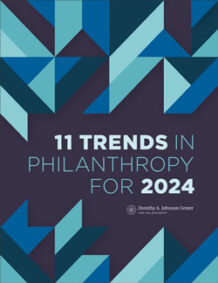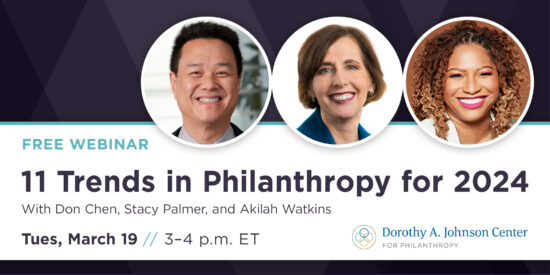11 Trends in Philanthropy for 2024


 When we think of “trends” in our everyday lives, we typically think of concrete things we can see, hear, or even eat. Popular songs, or brand names — the ubiquitous appetizer, the meme we can’t escape.
When we think of “trends” in our everyday lives, we typically think of concrete things we can see, hear, or even eat. Popular songs, or brand names — the ubiquitous appetizer, the meme we can’t escape.
Over eight years of producing 11 Trends in Philanthropy, the Dorothy A. Johnson Center for Philanthropy has most often taken this approach to our annual review of the sector, as well. Our team has combed the landscape of nonprofits and foundations for the most visible signs of a trend — the increased grant dollars, the emerging networks, familiar voices speaking up.
This year’s trends share a familiar wealth of examples, data, quotes, and research publications that can help us all anticipate the vectors of change. But at the core of 11 Trends in Philanthropy for 2024, readers will find a set of questions rather than answers. Each trend poses a number of moral, economic, equity-related, tactical, and other questions that the sector will have to answer.
In some cases — such as in the use of artificial intelligence in the workplace, or the adoption of new federal protocols for race and ethnicity data — those answers will come due very soon. In others — such as how institutional philanthropy addresses the glass cliff crisis among leaders of color or shifts resources to account for the U.S. South’s booming population — it may be years before we understand whether and how choices are made.
What we see most clearly for philanthropy in 2024 and beyond is that the field will wrestle with these questions. We look forward to the work ahead.
We are deeply grateful to the generous donors of the Lubbers Philanthropy Innovation Fund who made this work possible.

As we predicted in 2022, the restoration of incarcerated students’ access to federal Pell Grants has led to a rapid increase in the number of higher education in prison (HEP) programs and foundations’ interest in supporting them. With the expansion of these programs, however, comes the mandate to ensure effective and high-quality evaluation protocols are in place to provide meaningful and equity-centered information about program and student success. Leaders across philanthropy, higher education, and state and federal agencies are wrestling with the traditional use of recidivism as a marker of success and considering alternatives.

Despite being the fastest-growing racial or ethnic group in the U.S., AAPI communities face stark inequality and historical underfunding — not to mention chronic invisibility among donors and foundations. Recent advocacy efforts have gained momentum, however, and are addressing rising violence and discrimination. In many cases, members of AAPI communities themselves are leading and funding this change and supporting cross-sector actions (such as the creation of a Presidential advisory commission and other historic public sector commitments) to drive change. Organizations are urging funders to understand AAPI nonprofits, support visibility, invest in smaller organizations, and focus on long-term capacity building.

The “glass ceiling” is a well-known phenomenon affecting women and people of color as they advance through their careers. But increasingly, these same individuals — and especially Black women, who live at the intersection of gender and racial bias — are facing a further barrier to career success: the “glass cliff.” Research from inside and outside of philanthropy demonstrates how Black women and others are grappling with pay inequities, unrealistic expectations from boards and staff, and a generalized lack of support in their positions — all of which put workforce progress toward racial equity at risk.

Despite facing generational challenges in poverty, healthcare, systemic racism, and other issues that are often top-of-mind for major funders, the U.S. South has seen comparatively little institutional philanthropic investment over the decades. The recent whirlwind of on-the-ground activity from nonprofits and community groups aiming to improve outcomes across the region may be finally shifting that reality. Major new investments and initiatives from prominent players like the Ford Foundation, Arthur M. Blank Family Foundation, Kate B. Reynolds Charitable Trust, and others could spark a larger shift in attention and funding.

When the 2020 Census asked residents to identify their race and ethnicity, about 15% answered “some other race,” indicating that the provided list of racial categories did not fully — or at all — encompass their identity. The U.S. Census Bureau is now trying to update and expand federal protocols for collecting data on race and ethnicity. The move has sparked an uptick in advocacy at the state and national levels for increased disaggregation in data collection and reporting. If adopted, these changes will impact nonprofits, foundations, community discourse, and more.

Nearly three-quarters (74%) of Americans cite housing affordability as a major problem in their community. Factors such as high interest rates, inflation, climate instability, job market shifts, and population growth, exacerbated by the COVID-19 pandemic, have created a perfect storm affecting housing availability and affordability at the local level. By looking more deeply into the challenges faced by Denver, Colo., Austin, Tex., and Grand Rapids, Mich., we get a sense of how place-based funders and collaboratives are working to address this widespread issue.

Launching a new nonprofit is complex work, requiring founders to be expert generalists who can set up back-office operations, navigate legal certifications, and establish donor cultivation protocols all at once. In response to these challenges, fiscal sponsorship is gaining ground as an increasingly popular alternative model, one that can lift a mission’s administrative burdens and accelerate the work. However, there are caveats and key questions that all partners should consider before stepping into a fiscal sponsorship arrangement.

Philanthropy has already invested close to $1 billion in the development of artificial intelligence. With the advent of user-friendly AI interfaces like ChatGPT and Google’s Bard — as well as industry-specific tools that support grantwriting, fundraising, and other key areas of work — they’re beginning to make significant investments in human energy as well. The benefits of employing these tools are high, but nonprofits and foundations that venture into AI will need to be attentive to their potential shortcomings, as well.

Anonymity in the charitable sector has long been seen as an accepted norm — considered an important means of preserving donors’ safety and free speech and even increasing the moral value of a gift. However, debates about its public value and its potential pitfalls intensified after the Supreme Court’s Citizens United decision in 2010. Today, efforts to bring transparency to campaign finance are catching everyday nonprofits and donors in the spotlight, as well. The issue remains divisive, extending into discussions around donor-advised funds (DAFs), transparency and influence at universities and research institutions, and government overreach.

Gen Z — born between the mid-1990s and early 2010s — is entering adulthood facing compounding economic struggles, including higher living costs, weightier student loan debt, and increased expenses beyond what other generations have experienced. Despite limited disposable income, however, Gen Z shows a willingness to contribute to causes they care about, with statistics indicating higher donation rates and other markers of their commitment to the public good. As nonprofits and philanthropy consider how to engage — and what to expect — from this generation, a thorough understanding of their economic reality will be critical.

To say influencer marketing has become big business is an understatement. In less than a decade, it’s grown into an industry valued at over $20 billion. While the presence and role of influencers in philanthropy is less visible — and less discussed in institutional philanthropic circles — these everyday celebrities are leveraging their audiences and the unique functions of platforms like TikTok and Twitch to raise millions of dollars for their causes. In a time of declining donor engagement and donation size, new partnerships and paradigms between influencers, nonprofits, and communities may be advantageous for all.

In this recorded webinar, Johnson Center Executive Director Lesley D. Slavitt is joined by a panel of national field experts, including Don Chen (Surdna Foundation), Stacy Palmer (Chronicle of Philanthropy), and Akilah Watkins (Independent Sector), as they share an engaging exploration of this year’s trends in philanthropy and their relevance to the daily work of nonprofits, foundations, donors, advisors, and others.